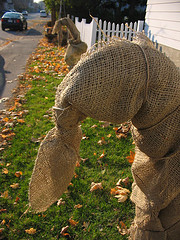Getting The Garden Ready for ...Winter
By Jos Van Hage

Gardening outdoors is coming to a close and this is the time of year when gardens and flowerbeds are cleaned up and plants are getting readied for winter.
To help strengthen trees and shrubs to survive the winter, it is good to fertilize them with a fertilizer high in potassium (last of the 3 numbers found on fertilizer) such as 0-0-50. It is always important to water all plants and bulbs so that they are moist when winter comes. This is especially true for those plants that are planted near the foundations of buildings and under eaves where there may not be as much rain and moisture. You also want to stake newly planted or fragile trees so that the winter winds won’t damage them. Use a 3-5 foot metal tree stake and place it 12-18 inches down into the ground 4-6 inches away from the main trunk of the tree. To attach the tree to the stake use rope, jute, an old garden hose, or anything that will not cut into the tree, so do not use wire or plastic. Cedar trees can have their branches damaged by wet, heavy snow so they should be tied with twine or you can wrap them with burlap or reemay. Broad-leafed evergreens such as rhododendrons and the evergreen ‘Alberta spruce’ should be wrapped with burlap to prevent windburn on the foliage.
Mice can be a real problem on trees and shrubs, over the winter months. They can easily kill a tree by ringing the tree just by eating the bark around the trunk of the tree. Most often you do not see this until the damage is done in spring because the mice hide under the snow. An easy preventive is to wrap the first 3-4 feet of tree trunk from the ground up with mouse guards. A mouse guard is an expandable plastic strip that wraps around the tree trunk making it almost impossible for mice to chew through. They are then removed in the spring and can be reused next fall again.
Perennials such as peonies, iris and lilies can still be divided and transplanted if they have gotten too large for their areas, or may not have done as well this year as in past years. When replanting always mix a handful of bone meal with the soil at the bottom of the hole before placing the plant in. This is also a good time to cut back the foliage on perennials to 6 inches from the ground. This tidies them up but leaves enough stems above the ground to entrap the snow over the winter giving the plant some extra warmth. On newly planted perennials or on those that may not be as hardy they should be given some extra mulch such as peat moss, or disease free leaves.
Roses should be pruned back to half of the new growth in the fall and then in the spring the fine tune pruning is done. Also, they can be given some extra protection by covering them with a Styrofoam rose hut or a bottomless pail filled with peat moss, wood chips or leaves.
When mowing the lawn for the last time, raise the blade a couple of notches so that there is some extra length in the lawn which gives the lawn some extra winter protection. Fertilizing the lawn with a winter feed fertilizer such as 6-3-12 will also strengthen the lawn getting it ready for winter.
These are just some of the chores that should be done in the next few days to get the garden ready for winter.
-Jos
Jos Van Hage owns and operates three Art Knapp Garden Centres in the Prince George area:
-Highway 97 north at Aberdeen
-Highway 16 West
Currently liquidating the store Highway 97 south at the Old Cariboo highway.
Previous Story - Next Story
Return to Home








